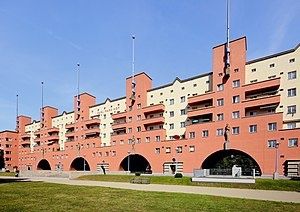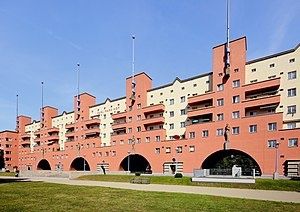Social Housing - Coming To A Discussion Near You.

Australia, Victoria, Banyule has a housing crisis which the media is constantly clamouring about.
Extraordinarily low rental vacancies, high rents for tenants, big mortgages and rising interest bills for landlords. No-one seems happy with the situation.
Desperate young families evicted and nowhere to go.
Retirees and separating couples sleeping in cars or couch-surfing.
Young workers & students returning to Mum & Dad's place with their tails between their legs.
You, like me, are unlikely to have ever heard of Hugo Breitner.
Pity.
That needs to be put to rights, as the long-departed Hugo Breitner has made an outstanding contribution to the welfare and contentment of city-dwellers.
BREITNER, HUGO (1873–1946)
Austrian socialist economist. Born in Vienna, he worked as a clerk in the Landesbank, one of Vienna's leading banks, and was prominent in the bank clerks' union.
Breitner became a director of the bank, but relinquished this post in 1918 to take charge of the city's finances at the invitation of the socialist municipal council. He remained in this post until 1932 when he retired due to ill health.
Breitner was a government adviser during the economic crisis of 1919–22, and persuaded the Austrian government to institute a taxation policy which alleviated the tax burden of the lower classes at the expense of the rich and could provide housing for the poor.
The government actually built over 60,000 cheap and comfortable homes for workers which became the model for other European cities.
Good work, Hugo. Hats off to you and a deep bow as well.
Social Housing in Vienna
A civilised place Vienna. Breath-taking architecture, wide streets, clean, opera, coffee houses, lipizzaner horse dancing.

Not a place you would expect to be a stand-out for social housing. But there you are.
Proud Melbournians - custodians of Richmond, Collingwood, Carlton and North Melbourne housing towers - need to pay attention.
Huge public housing complexes can apparently be desirable places to live even for the middle classes, professional people, retirees and other fine people.
A most remarkable example is Karl-Marx-hof. Yep, the Father of Communism, mate of Engels, Communist Manifesto and all that. That Marx.

Impressive statistics.
Social housing is livable, and it’s available to the middle class. You can earn up to twice the average salary in Vienna and still qualify.
The city owns 1,800 apartment complexes. The people who live there include tech workers, retired grandmas, immigrants and middle-class families. Most residents pay no more than 25% of their income in rent, Vienna’s subsidized housing makes up 44% of the city’s rental stock.
How did this come about?
Karl-Marx-Hof (pictured above) was built on land that, until the 12th century, had been under the waters of the Danube, deep enough for ships to travel over the area.
By 1750, all that remained was a pool of water, which was drained on the order of Holy Roman Emperor Joseph II.
Gardens were then built in the area, but these were removed by the Vienna city council, then under the "Red Vienna" period of control by the Social Democratic Party of Austria to make room for the erection of Karl-Marx-Hof.
This was financed by a special tax named after councillor Hugo Breitner, commissioning locally and internationally renowned architects.
Karl-Marx-Hof was built between 1927 and 1930. It held 1,382 apartments (with a size of 30–60 m2 each). Only 18.5% of the 156,000 m2-large area was built up, with the rest of the area developed into play areas and gardens.
Designed for a population of about 5,000, the premises include many amenities, including laundromats, baths, kindergartens, a library, doctor's offices, and business offices.
Damage from heavy artillery to Karl-Marx-Hof in WW2 was repaired in the 1950s.
It has been used as a filming location for some movies, most notably The Night Port
The building was refurbished between 1989 and 1992.
The 1% tax for social housing
In Austria, many consider public housing, known as social housing, affordable and desirable. Think rooftop swimming pools and saunas, on-site child care, cafes and tennis courts.
In Vienna, nearly 3 out of 5 residents live in social housing, and many say that’s one reason the Austrian capital consistently ranks high in quality of life. So how does the city make it work?
Vienna’s city government owns and manages 220,000 housing units, which represent about 25 percent of the city’s housing stock.
These city-owned housing units, called social housing, are meant primarily for lower-income residents.
The city also indirectly controls 200,000 units that are built and owned by limited-profit private developers but developed through a city-regulated process.
Vienna adopted the latter approach in the 1980s, when it decided to collaborate with the private sector to build affordable housing rather than developing and owning more public housing.
The city buys land deemed suitable for residential development and retains control over the type and nature of development. The city then solicits proposals from various private developers, which will build and retain ownership of the housing units.
A jury evaluates these proposals based on four criteria:
• architectural quality,
• environmental performance,
• social sustainability, and
• economic parameters such as proposed rent levels and costs.
After the jury selects a developer, the city sells the land to the developer at an affordable price. In addition, the city gives the developer a loan with favorable terms such as low interest rates and extended repayment periods.
Private developers who collaborate with the city government to build affordable housing must allow the city to rent half of the new apartments to lower-income residents; the developer generally leases the remaining units to moderate-income residents.
In some projects, future tenants participate in the planning, design, and construction process and give input on what kind of facilities they would like to have in the building.
A unique feature of Vienna’s social housing program is that the city’s income restrictions for subsidized units only apply when families first move in.
Residents are never required to move out, even if household income levels increase in the following years.
This arrangement results in a substantial number of moderate-income residents living in subsidized housing, and this mixing together of residents with different income levels helps with social integration.
Since the city has a large stock of affordable housing, these middle-income residents typically do not crowd out lower-income residents.
Because the city continues to add new units that are subsidized, about 5,000 annually, and available to lower income residents, housing developments do not devolve into middle-class enclaves nor do they become stigmatized concentrations of poverty.
Member discussion